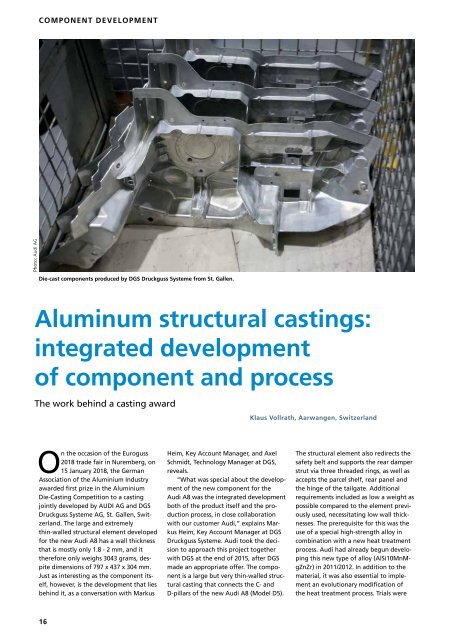CPT International 02/2019
- No tags were found...
Create successful ePaper yourself
Turn your PDF publications into a flip-book with our unique Google optimized e-Paper software.
COMPONENT DEVELOPMENT<br />
Photo: Audi AG<br />
Die-cast components produced by DGS Druckguss Systeme from St. Gallen.<br />
Aluminum structural castings:<br />
integrated development<br />
of component and process<br />
The work behind a casting award<br />
Klaus Vollrath, Aarwangen, Switzerland<br />
On the occasion of the Euroguss<br />
2018 trade fair in Nuremberg, on<br />
15 January 2018, the German<br />
Association of the Aluminium Industry<br />
awarded first prize in the Aluminium<br />
Die-Casting Competition to a casting<br />
jointly developed by AUDI AG and DGS<br />
Druckguss Systeme AG, St. Gallen, Switzerland.<br />
The large and extremely<br />
thin-walled structural element developed<br />
for the new Audi A8 has a wall thickness<br />
that is mostly only 1.8 - 2 mm, and it<br />
there fore only weighs 3043 grams, despite<br />
dimensions of 797 x 437 x 304 mm.<br />
Just as interesting as the component itself,<br />
however, is the development that lies<br />
behind it, as a conversation with Markus<br />
Heim, Key Account Manager, and Axel<br />
Schmidt, Technology Manager at DGS,<br />
reveals.<br />
“What was special about the development<br />
of the new component for the<br />
Audi A8 was the integrated development<br />
both of the product itself and the production<br />
process, in close collaboration<br />
with our customer Audi,” explains Markus<br />
Heim, Key Account Manager at DGS<br />
Druckguss Systeme. Audi took the decision<br />
to approach this project together<br />
with DGS at the end of 2015, after DGS<br />
made an appropriate offer. The component<br />
is a large but very thin-walled structural<br />
casting that connects the C- and<br />
D-pillars of the new Audi A8 (Model D5).<br />
The structural element also redirects the<br />
safety belt and supports the rear damper<br />
strut via three threaded rings, as well as<br />
accepts the parcel shelf, rear panel and<br />
the hinge of the tailgate. Additional<br />
requirements included as low a weight as<br />
possible compared to the element previously<br />
used, necessitating low wall thicknesses.<br />
The prerequisite for this was the<br />
use of a special high-strength alloy in<br />
combination with a new heat treatment<br />
process. Audi had already begun developing<br />
this new type of alloy (AlSi10MnMgZnZr)<br />
in 2011/2012. In addition to the<br />
material, it was also essential to implement<br />
an evolutionary modification of<br />
the heat treatment process. Trials were<br />
16

















